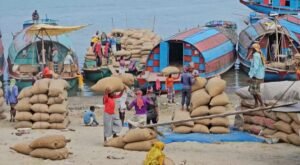Ashuganj’s Century-Old Rice Market Home / BOC Ghat sits about...
Read MoreTop 7 Wonders of Bangladesh
Do you know why Bangladesh holds a special place in the eyes of the world? Yes, you got it right. Today’s discussion is about some truly unique things about Bangladesh.
Most of these are nature’s gifts, thanks to the country’s geographical location. These 7 wonders of Bangladesh will make you more interested and excited to travel here.
So, let’s discover the 7 wonders of Bangladesh!
1. World Biggest Fresh water and rivers hub
Wherever you go in Bangladesh, you’ll see rivers, canals, lakes, or wetlands. Across the country, these waterways are spread out like the veins of a human body.
This natural resource has made Bangladesh one of the richest countries in the world in terms of fresh water. It’s said that Bangladesh holds 10% of the world’s total fresh water.
As a river-based country, Bangladesh has around 700 rivers, big and small. Thanks to these rivers, canals, and water bodies, Bangladesh has always stood strong against global superpowers.
The soft, fertile land and the web of rivers and streams naturally created obstacles for any major land invasion.
2. Bengal Delta
Bangladesh is a country whose land has mostly formed from river-borne silt. Over nearly 120 million years, silt from the Padma and Jamuna rivers—originating in the Himalayas—has gradually created the land of Bangladesh. And this process of land formation still continues today.
In the southern part of Bangladesh, where the rivers meet the Bay of Bengal, new small and large sandbars quietly rise from the sea even now.
The Bengal Delta is the largest delta in the world. It also has the most fertile soil on Earth. Wherever a seed is planted, it grows into a tree. That’s why the main occupations here include farming, fishing, river transport, and animal husbandry.
3. Hilsa Fish
Hilsa is a type of fish that is found in only a few countries around the world. Notably, it is found in some South Asian countries such as Bangladesh, India, Pakistan, Myanmar, and Sri Lanka.
A very small amount is also found in a few Middle Eastern countries. Historically, hilsa has mostly originated in the Bay of Bengal and its surrounding regions. The meeting point of the Padma and Meghna rivers in Bangladesh is the world’s largest hilsa-producing area.
Bangladesh alone supplies 85% of the world’s total demand for hilsa, while the remaining 15% comes from other South Asian countries. In Bangladesh, hilsa is known as the king of fish.
This title didn’t come without reason. Hilsa is not only beautiful to look at, but also incredibly tasty. When cooked, its aroma spreads to nearby homes.
4. Baklai falls
Among all the natural waterfalls in Bangladesh, Baklai Waterfall, located in Thanchi, Bandarban, is known worldwide. The well-known website sevenwonders.org has ranked Baklai Waterfall as the number one natural wonder of Bangladesh.
Height: This is the highest natural waterfall in Bangladesh, standing at 380 feet.
Location: It is situated in a very remote area of Thanchi, Bandarban, between Bangladesh’s highest mountain peaks, Tajingdong and Keokradong.
Adventure Trekking: Among the world’s toughest and most challenging mountain treks, the route to Baklai Waterfall is one of them. To reach it, travelers must cross steep slopes, rugged hills, and deep forests.
In some cases, it takes 5 to 7 days of trekking through the mountains to see this waterfall. Those who have completed this adventure still remember the thrill of this green jungle for the rest of their lives.
5. Cox’s Bazar Sea beach
Cox’s Bazar is known as the longest sea beach in the world. This uninterrupted beach stretches for 120 kilometers across three locations: Cox’s Bazar, Ukhiya, and Teknaf. To enjoy the beach to the fullest, a special road called the Marine Drive has been built.
If you travel the entire 120-kilometer stretch, you’ll witness the sea at the foot of vast hills, dense hill forests, rows of casuarina trees, and lush green landscapes.
The Teknaf Marine Drive is also recognized as the longest marine drive in the world. Along with the golden sandy beach, you’ll also see red crab beaches, colorful traditional fishing boats, and ancient salt farming.
6. Sundarbans
The Sundarbans, located in the southwest region of Bangladesh, is known as a natural sea barrier and the largest mangrove forest in the world. About 40% of this forest lies in India. Its total area is nearly 10,000 square kilometers.
The Sundarbans is the largest habitat of the world-famous Royal Bengal Tiger in Bangladesh. Besides that, it is home to thousands of species of birds and animals and holds Bangladesh’s richest natural honey reserves.
The Sundarbans is also recognized as a UNESCO World Heritage hotspot. It is famous for rare animals like the Chitra deer, saltwater crocodiles, and dolphins.
The saltwater trees and their breathing roots give the forest a unique and extraordinary beauty.
7. Jamdani
The 15th-century muslin fabric is a golden chapter in Bangladesh’s ancient history and heritage. It is said that the British government at the time encouraged women in the country to buy less muslin, trying to protect the nation’s wealth from dwindling.
The British killed many muslin weavers to protect their own trade interests. This muslin saree was so finely woven that a single saree could pass through a ring.
One type of this original muslin is Jamdani, which is still produced in Bangladesh today. Its special feature is that it is completely handmade. Depending on the design, making one saree can take from one month up to a year.
Each saree can cost between 5,000 and 100,000 taka. In Bangladesh, the Jamdani saree is recognized both as a GI (Geographical Indication) product and is listed on UNESCO’s World Heritage list.
The Culture of Eid al-Adha in Bangladesh
The Culture of Eid al-Adha in Bangladesh Eid al-Adha is...
Read MoreFishing Trawler Made in Bangladesh
Home / Fishing Trawler Made in Bangladesh About 10 kilometers...
Read MoreIs Bangladesh safe for travel ?
Home / Is Bangladesh Safe For Travel ? Bangladesh is...
Read More


